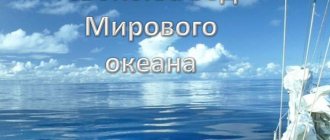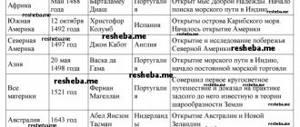so UNT / Geography / Lesson plans for geography 7th grade
Lesson #60: The Pacific Ocean.
28.02.2014 5327 0
Purpose of the lesson: 1) To develop knowledge about the geographical location and organic world of the Pacific Ocean; 2) Develop the ability to work with a map; 3) Cultivate interest in the subject.
Teaching method: verbal
Form of organization: collective
Lesson type: combined
Lesson type: problem-based learning
Equipment: 1. Physical map of the world. 2. Videotape “These mysterious animals -1” 2 “Cunning defense” p. 10-15. 3. Disc VVS-8 side B “Blue Planet” episode 7 ep. 7→, 8 episode ep. 1. 4. Disc VVS-8 side B “Walking under water”
Episode 2 4.
I. Organizational moment. Greetings. Identification of missing persons.
II.Checking homework.
1. Commonwealth of Australia (6th place in area, population 18 million people, the majority of the population in large cities - 86%; industrial-agrarian country; mining, mechanical engineering, woodworking, chemical and food industries; first place in sheep breeding (merino sheep ); on York Island there are bauxites; in the southeast and southwest - wheat, in the subtropics - pineapples, bananas, sugar cane, on irrigated lands near cities - vegetables and fruits)
2. Population (Aborigines with mestizos make up 1%, 200 tribes, speak different languages, Australian group of the Negroid race, previously engaged in hunting and gathering; boomerang; previously the Aborigines inhabited the eastern, most favorable part of the continent; Anglo-Australians pushed the Aborigines into the central desert and semi-desert zones - reservations; some still lead a primitive lifestyle; some are well educated; artist Albert Namatjir could not get to his exhibition in Sydney - Aboriginal people are prohibited from approaching within 5 km of the city)
III.Comprehensive knowledge testing.
1. Lithosphere is (a shell that consists of the earth’s crust and parts of the upper mantle)
2.Endemic of the mountain Tien Shan (Tien Shan spruce)
3. Which navigator was the first to travel around the world? (F. Magellan)
4. The reason for the densest river network in the equatorial and subequatorial belts is the large amount of (precipitation)
5. The largest area of South America is located between (the equator and the southern tropics)
6. The qualitative background on the political map of the world is (territories of states)
7. The last thing to appear in nature was (biosphere)
8. At the base of modern continents lie the oldest relatively stable and leveled sections of the earth’s crust (platforms)
IV.Preparation for explaining a new topic. Write the topic of the lesson on the board and explain the objectives of the lesson. Problematic question: For what purposes do people use the Pacific Ocean?
V. Explanation of a new topic.
1. Features of the Pacific Ocean (area 178.6 million km²; length from west to east 19 thousand km, from north to south 16 thousand km; water volume 710 million km³ (53% of the World Ocean); Mariana Trench 11022 m; average depth 4 thousand km; average water temperature +19.4°C; 10 thousand islands)
2. Geographical location (the main part is in the western hemisphere, washes all continents except Africa, the coasts of Eurasia are strongly indented (find and mark the bays and seas of the Pacific Ocean on the contour map))
3. Research (discovered and described by Magellan; in the 19th century, the Russian research vessels “Vityaz” and the English “Challenger” collected a lot of information about the nature of the ocean, Russia organized 40 research expeditions in the 19th century, systematic research began in the second half of the 20th century; in 1947, the Norwegian Thor Heyerdahl made the first trip from Peru to the shores of Polynesia on the Kon-Tiki raft to prove that the islands were inhabited by Native Americans; in 1943, Jacques Cousteau and E. Gagnan invented scuba gear, appeared the ability to stay under water for 1.5-2 hours; research vessel “Calypso” Cousteau; in 1957 “Vityaz” discovered the Mariana Trench)
4. Nature (the oldest ocean, located on the Pacific lithospheric plate; plate collision boundaries - island arcs, trenches, marginal seas - the Pacific Ring of Fire; continental shelf only near Asia and Australia; average basin depth 6000-8000 m (East Pacific underwater ridge ); the largest group of volcanic islands is the Hawaiian Islands; the Pacific Ocean covers all climatic zones except the Arctic zone; in the south the temperature is lower than in the north of the ocean (why?); surface water temperatures from -1 ° C at polar latitudes to + 29°C at the equator; trade winds blow at the equator, precipitation 2000 mm; in the northwest - monsoons; in the tropics at the end of summer, beginning of autumn - typhoons; in the temperate zone - westerly winds, especially strong in the southern hemisphere (waves reach 25- 30 m in height); large amounts of precipitation on the western coasts in the path of westerly winds; due to the large amount of precipitation in the Pacific Ocean, the salinity of surface waters is not high)
5. Flora and fauna (many ancient and giant species - sea urchin, sabertail, fur seal, sea beaver, elephant seal; 95% of species live off the coast of Eurasia (cold and warm water are mixed); pollock, flounder, crabs are caught; coral reefs on the shallows of the Sunda Islands and the coast of Australia (molluscs, echinoderms, crustaceans); in equatorial waters, flying fish, sperm whales, sharks, tridacna (a giant bivalve mollusk up to 300 kg); near the South American coast in the tropics, where warm and cold currents meet - anchovies , mackerel, mackerel, whales, fur seals, sea beavers, squid, octopuses; in the temperate zone of the southern hemisphere - brown algae 200 m long; in the cold waters of Antarctica - leopard seals, seals, giant blue whales, penguins, birds)
6. Use of the Pacific Ocean (on the coast - more than 50 countries, where half the world's population lives; shrimp, shellfish, algae, seaweed are fished; oil, coal, sea salt are mined; important sea routes)
7. Ecology of the Pacific Ocean (pollution with oil, radiation, industrial waste; fish have become poisonous from mercury; sea cows have disappeared; hunting for whales and fur seals is prohibited)
VI. Mastering a new topic.
Working with the map and questions in the textbook.
VII.Homework. § 57, k.k. – bays, islands, peninsulas, seas, basins.
VIII. Lesson summary. Commenting on ratings.
Conclusion: The Pacific Ocean is the largest ocean in area, inhabited by a unique organic world. It is necessary to protect ocean flora and fauna!







